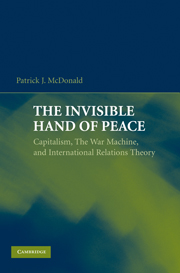Book contents
- Frontmatter
- Contents
- List of Tables
- Acknowledgments
- 1 American Grand Strategy and the Liberal Peace
- 2 Liberal International Relations Theory on War
- 3 Releasing the Invisible Hand
- 4 Liberal Economic Institutions and Peace in the Twentieth Century
- 5 Free Trade and Peace in the First Era of Globalization
- 6 From Rivalry to Friendship
- 7 The Achilles' Heel of Liberal International Relations Theory?
- 8 Peace Across the Taiwan Strait?
- 9 The Invisible Hand or the Ballot Box?
- 10 Capitalism and America's Peaceful Market Power
- References
- Index
4 - Liberal Economic Institutions and Peace in the Twentieth Century
Published online by Cambridge University Press: 05 June 2012
- Frontmatter
- Contents
- List of Tables
- Acknowledgments
- 1 American Grand Strategy and the Liberal Peace
- 2 Liberal International Relations Theory on War
- 3 Releasing the Invisible Hand
- 4 Liberal Economic Institutions and Peace in the Twentieth Century
- 5 Free Trade and Peace in the First Era of Globalization
- 6 From Rivalry to Friendship
- 7 The Achilles' Heel of Liberal International Relations Theory?
- 8 Peace Across the Taiwan Strait?
- 9 The Invisible Hand or the Ballot Box?
- 10 Capitalism and America's Peaceful Market Power
- References
- Index
Summary
This chapter begins the empirical evaluation of this book's two key hypotheses linking the predominance of private property and competitive market structures to peace. It draws on well-established practices in the large liberal peace literature to ensure comparability with the findings presented here. For the most part, this research program has drawn on multivariate statistical analysis to evaluate whether democracy and international trade promoted peace during the post–World War II period. This research technique identifies broad relationships among variables that measure such concepts as commercial integration, regime type, military power, and military conflict across multiple countries and over multiple time periods. The statistical analysis presented here thus tests for the presence of any historical association between liberal economic institutions and the outbreak of military conflict between states.
This analysis is comprised of two parts. Each part focuses on whether one of the two domestic institutions alters the likelihood that governments utilize military force to settle their political disputes with each other. If these hypotheses are correct, the following relationships should be observed. First, governments possessing high quantities of public property should utilize military force to settle political disputes with other governments at a higher rate than governments with more privatized economies. Second, governments adopting free-trade policies should enter military disputes at a lower rate than those adopting more mercantilist or autarkic commercial policies.
- Type
- Chapter
- Information
- The Invisible Hand of PeaceCapitalism, the War Machine, and International Relations Theory, pp. 77 - 110Publisher: Cambridge University PressPrint publication year: 2009

